May 8, 2014 | Sandy Giardi
Heavy hitters in horticulture divulge the plants they dig and why….
Flower power is in full force this month, and everyone—from self-proclaimed green thumbs to those who hire them—wants sensational-looking, successful gardens. Spending time in your own personal Eden is one of springtime’s greatest pleasures. That’s why we asked some of the Boston area’s finest landscape designers and architects—namely, Dan K. Gordon Landscape Architects, Parterre Garden Services and a Blade of Grass Landscape Design—to share their favorite plant picks for perennial, formal and woodland gardens. Our panel of experts happily complied, parting with a few trade secrets on the blooms that work best here in New England and why they love them.
Perennial Garden by Dan K. Gordon Landscape Architects; Photography by Peter Vanderwarker
Perennial Gardens
Landscape designers and architects put careful thought into perennial gardens, and are rewarded by ever-changing beds with sweeping color changes and evolving natural palettes of (seemingly) easy beauty. But for a perennial garden, it’s not only about what Parterre Field Director Vanessa Tropeano terms an exciting “series of transformations” or “bloom times and colors,” says Landscape Designer Kathryn Ostermier of Dan K. Gordon Landscape Architects. It’s also about “reliable plants,” adds Ostermier, with “multi-season interest, including summertime shapes and textures, fall color and winter form.”
PICKS:
Dan K. Gordon Landscape Architects:
‘Caesar’s Brother’ Siberian Iris
‘Sarah Bernhardt’ Peony
Lady’s Mantle
Sage
Stonecrop
Perennial Garden by Dan K. Gordon Landscape Architects; Photography by Peter Vanderwarker
‘Sarah Bernhardt’ Peony “has beautiful, light pink blooms in late spring, and its attractive foliage and form are useful in filling out a perennial garden,” says Ostermier. Come summer, ‘Caesar’s Brother’ Siberian Iris “has beautiful purple blooms, and its spiky foliage contrasts with the broad, velvety leaves of Lady’s Mantle.” Lady’s Mantle’s “fine-textured chartreuse bloom” is a perfect foil for Sage’s purple blossoms—as both flower all summer long. Stonecrop “provides flower and foliage” maintains Ostermier. Also known as Sedum ‘Autumn Joy,’ this plant is just that as it takes on a deep pink to copper hue as fall progresses, and “if seed heads are left on,” says Ostermier, it’s “a beauty in winter covered in snow and ice.”
Parterre:
Pink Poppy
False Indigo
Calamintha
A spring/early summer perennial garden by Parterre Garden Services
Tropeano adores these showy yet delicate Pink Poppies against the skyward-reaching purple spires of False Indigo, and maintains that “they provide a beautiful complement to the soft green foliage” of this spring/early summer garden. These blooms “gear up for a color explosion in midsummer when the Calamintha “provides a frothy white texture” and “blooms all summer long.” Apart from its texture, Tropeano adores Calamintha as it “attracts pollinators, requires minimal maintenance (i.e. no dead-heading!)” and has a surprising seasonal change in that, come autumn, its “blooms turn pale blue” while “its foliage turns deep burgundy.”
Late summer perennial garden by Parterre Garden Services
a Blade of Grass:
Nepeta ‘Walker’s Low’ Catmint
Red Knock Out Rose
Perennial garden by a Blade of Grass Landscape Design
Mass. Certified Horticulturalist Heather Lashbrook Jones fancies the combination of the sculptural stalks of the purple Nepeta ‘Walker’s Row’ Catmint against the shocks of color of the bright pink Knock Out Roses (the color is deceiving, as “Red” Knock Out Roses actually appear pink). The roses “bloom all summer long,” says Jones, and the Nepeta “can be sheared back midsummer to create even more blooms and help keep its shape.”
Formal Gardens
Beautifully manicured and structured, formal gardens “are all about geometry and repetition,” contends Tropeano, and, we might add, dignity. Botanical studies of shape, line and pattern, formal gardens are highly decorative, traditionally incorporating “low-growing hedges that take well to pruning and shaping” says Ostermier, pathways of greenery, gravel or intricate stonework, and oftentimes, statuary and fountains.
Dan K. Gordon Landscape Architects:
Boxwood
‘Carefree Beauty’ Rose
Nepeta ‘Walker’s Low’ Catmint
Woodland Sage
Formal garden by Dan K. Gordon Landscape Architects; Photography by Bob O’Connor
Ostermier prefers a “tried-and-true, classical combination” for formal gardens. Boxwoods are “a natural for framing the geometric planting beds” and for showcasing the “bright pink blooms” of ‘Carefree Beauty’ Roses. In this parterre, the shrub rose’s blossoms create clusters of color that lend romance to the austerity of the patterned brickwork. These vibrant roses flower from spring to late fall, explains Ostermier, and are surrounded by a flush of purple in the summer, when the blooms of Nepeta ‘Walker’s Low’ Catmint and Wood Sage reveal their glory.
Parterre:
Boxwood
Arborvitae
Amelanchier Trees
Limelight Hydrangea
Formal garden landscape design by Gregory Lombardi Design; Garden installation and maintenance by Parterre Garden Services
Boxwood hedges and Arborvitae are first-rate choices when designing the “layout of a structural, formal garden,” says Tropeano. Parterre adds height with the addition of Amelanchier Trees as a “frame in the center” and to soften “the rigorous formal elegance” of this garden. The white to pink blush of their flowers in springtime and the golden hues they take on in autumn provide a visual counterpoint to the deep greens of the shrubs. Limelight Hydrangea used in repetition, says Tropeano, makes for another “great addition to soften [a formal garden’s] strict edges.”
a Blade of Grass:
Boxwood
Rose
Peony
Salvia ‘May Night’
Formal garden by a Blade of Grass Landscape Design
Woodland Gardens
Woodland gardens are “typically native,” offers Tropeano, and often found under a canopy of trees or lining a footpath. Parterre, as well as Dan K. Gordon Landscape Architects and a Blade of Grass, focuses on texture when choosing plants for a woodland landscape, rather than “the effusion of color that might be found in a perennial garden.” The trick to designing stunning woodland gardens is to create a peaceful, natural expanse in which the hand of the landscaper is undetectable. This effect can be achieved by layering dense, shade-loving plantings of all heights—from the ground cover up.
Dan K. Gordon Landscape Architects:
Boule de Neige Rhododendron
Mountain Laurel
Oakleaf Hydrangea
Bleeding Heart
Lady Fern
Sensitive Fern
Woodland garden by Dan K. Gordon Landscape Architects; Photography by Peter Vanderwarker
Woodland garden by Dan K. Gordon Landscape Architects; Photography by Peter Vanderwarker
For Dan K. Gordon Landscape Architects, it’s essential that the plants selected “provide more than one season of interest,” explains Ostermier. Hence, they’ve chosen the foliage of Boule de Neige Rhododendron, Mountain Laurel and Oakleaf Hydrangea as “the thick shrub layer behind the lower plantings of their woodland setting.” The plants flower in succession: Boule de Neige’s bright white flowers pop in early spring, Mountain Laurel’s demure blooms follow in late spring and early summer, while Oakleaf Hydrangea blossoms in summer before providing fall foliage and “cinnamon exfoliating bark that adds winter color and texture.” At the foot of the larger screen plantings, Bleeding Heart’s “droops of pink flowers and fine foliage texture are offset by the lush greenery of Lady Fern and Sensitive Fern.” Raves Ostermier, “We love the way these low-growing woodland plants look when lining a pathway or planted as broad swaths underneath trees.”
Parterre:
Variegated Solomon’s Seal
Lady Fern
Ostrich Fern
Christmas Fern
Witch Hazel
Woodland garden landscape design by Gregory Lombardi Design; Garden installation and maintenance by Parterre Garden Services
Parterre prizes Variegated Solomon’s Seal for its “seasonal interest,” as “soft white blooms” grace the plant in the spring, and its foliage “turns a beautiful golden yellow in the fall.” “Ferns are a must,” says Tropeano; the feathery fronds of Lady Fern and Ostrich Fern yield an array of shapes and sizes that lend softness and serenity to a landscape. “Christmas Fern is a favorite for the fiddleheads that appear in early spring,” says Tropeano, and for the evergreen “carpet” it brings to a woodland garden throughout the year. “For a bit of color in the fall, shrubs are a good choice.” Witch Hazel is a standout “for its golden and red hues.”
a Blade of Grass:
Sweet Woodruff
Hosta
Solomon’s Seal
Astilbe
Hakonechloa Grass
Woodland garden by a Blade of Grass
For a Blade of Grass’ woodland garden, Jones also favors Solomon’s Seal, no doubt for the graceful arch of its foliage and pendant blooms, as well as the lacy ground cover Sweet Woodruff. With small, wheel-like leaves punctuated by tiny white blossoms in early spring, Sweet Woodruff provides a pleasing contrast to the Hosta’s oversized leaves and stand-at-attention blooms. Astilbes, with their jade-blue leaves and plume-like blossoms, is Jones’ preferred perennial—its purple shade “looks great” when paired with Hokonechloa Grass or Japanese Forest Grass—tall, willowy clusters that delight and thrive in woodland gardens.
Written by Sandy Giardi



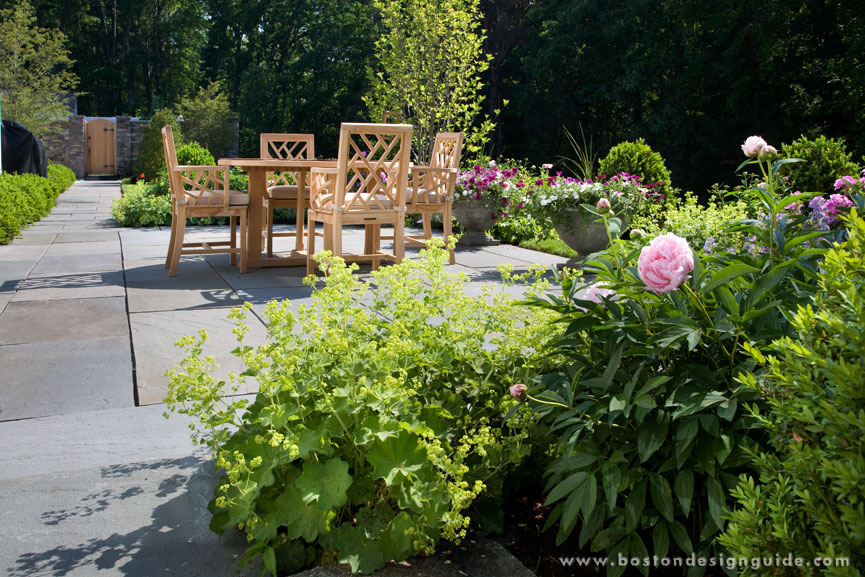

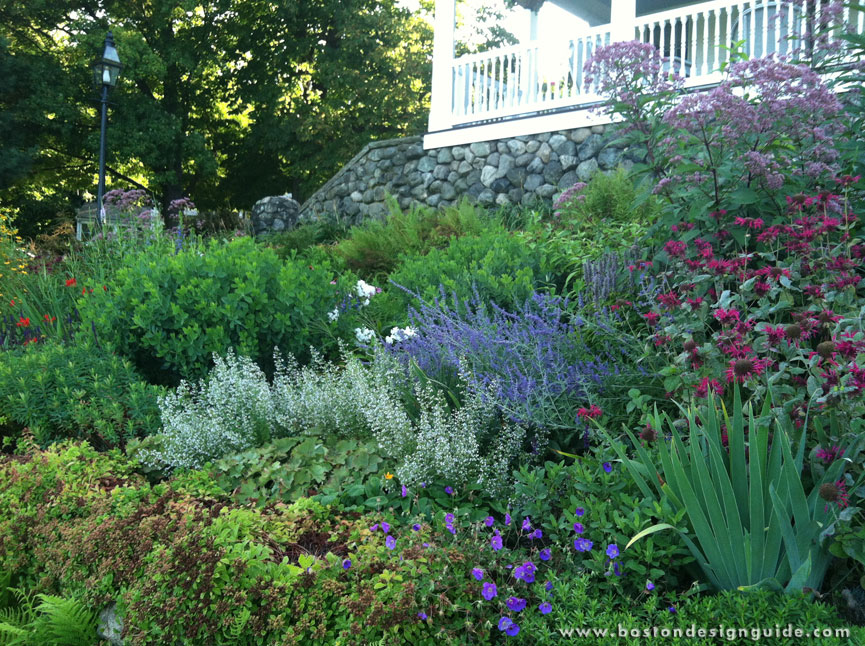

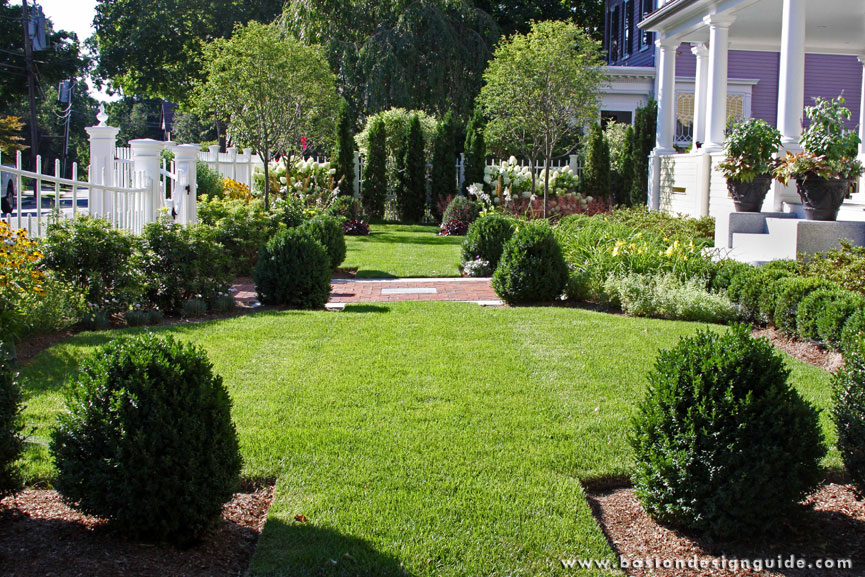

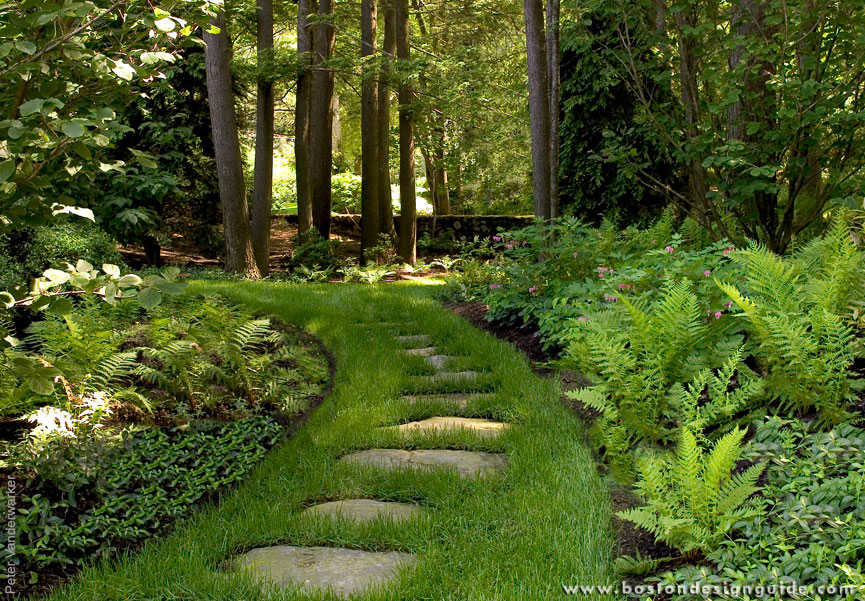

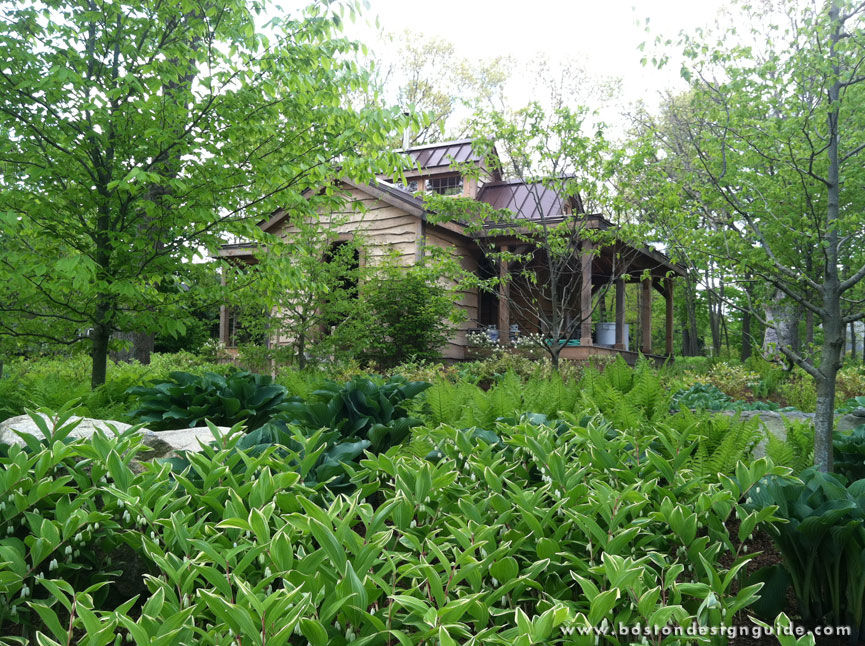

Add new comment